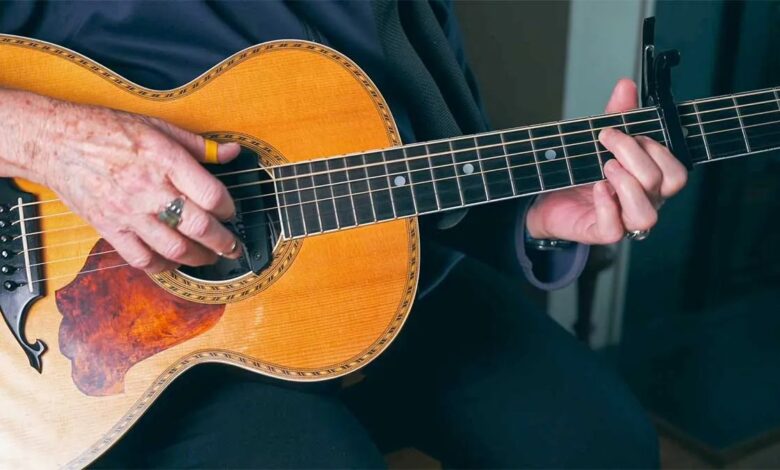Explore Open-D Tuning with Mary Flower’s Colorful Arrangement of “Dink’s Song”

I credit Joni Mitchell for inspiring me to leave college and pursue a career in music. During those years, I figured out her song “I Had a King” in open-G tuning, which quickly became a mainstay of my repertoire. Mitchell’s songs were stunningly original, and I discovered how hard it was to sound bad in open tunings—whether playing the blues or creating instrumentals. It was all about using my ear to find the treble melodies and letting the open bass strings ring. The process felt like solving a puzzle, with results that almost always worked.
That same sense of discovery comes to me when arranging in open D. “Dink’s Song,” a classic American folk tune recorded by artists like Bob Dylan, Dave Van Ronk, and Mitchell, is a perfect candidate for this tuning. With its simple, movable chord shapes—many requiring just two fingers—open D adds a shimmering quality to the song.
“Dink’s Song” dates back to 1909, when ethnomusicologist John Lomax recorded a woman named Dink singing it in Texas. It’s a timeless story of a woman abandoned by her lover, first published in John and Alan Lomax’s American Ballads and Folk Songs. I recorded a version of it on my 2003 album, Ragtime Gal, and in this lesson, I’ll walk you through the process I used to arrange it. These techniques can be applied to many of your favorite folk tunes, opening up a world of creative possibilities.
The Tuning and Basic Progression
If you’re unfamiliar with open D, here’s how to get into it from standard tuning: Lower your sixth string a whole step to D, then do the same with your first and second strings, tuning them to D and A, respectively. Finally, lower your third string a half step, from G to F#. Now your open strings (low to high: D A D F# A D) form a D chord, offering a rich, open sound ideal for folk arrangements.
There is no real melody written into this arrangement but instead a waterfall of movement throughout the song as accompaniment to the vocal. The picking hand plays basic arpeggios, as opposed to any common pattern, often with a pinch (thumb and index finger) on the fretted strings. Example 1 shows the chord shapes that make up the accompaniment of the first two vocal lines. It’s good to practice these in the order shown so the fretting hand becomes used to the descending chords.
Once you are familiar with the shapes, try Example 2, which shows the arpeggiated picking of that progression. Note how the fourth-fret pinch on beat 2 not only adds descending bass movement but adds harmonic color through the major seventh (C#). This is followed by the V chord, G, with the addition of the ninth (A). The progression ends on the V chord (A), played as a dominant seventh without the third. With this figure, you have most any three-chord folk song at your fingertips in open-D tuning.
Adding Contrast
To make the arrangement more dynamic and interesting, I added parts that contrast with the main arpeggiated progression. Example 3 shows what I play in the intro and between verses—a series of descending sixths on strings 1 and 3. These dyads require a different fingering than you would use in standard tuning; fret string 3 with the first finger and string 1 with the third finger. It might take some time to get used to this figure and fingering, but it’s worth the effort for the poignant sound the interval imparts.
The line on the bottom three strings that starts on beat 3 of the first measure of Ex. 3 is derived from the D major pentatonic scale (D E F# A B), with the addition of a blue note (F). I use my second finger to play each hammer-on and my third finger for the slide from the third to the fourth fret, making sure it sounds as smooth as possible.
At the end of each verse, I play a variation on this figure. As shown in Example 4, instead of sixths on strings 1 and 3, I opt for thirds in a lower register, on strings 3 and 4, followed by a shortened variation of the line on the bottom strings. Note how on beat 3 of the first bar, I slide into the thirds from a half step below, which lends a bluesy quality, then down two frets. It might take a bit of practice to get this double slide to sound clean, but again it’s worth it, as these are ornaments you can add elsewhere.
Putting It All Together
Example 5 depicts a verse of the song as it appears on the recording. Notice how in measures 11 and 12, the two-finger chords descend, each one followed by the open first string. This, for me, is a highlight of the arrangement; I love the smooth movement and the textural contrast between the fretted notes and open strings. Keep in mind as you play this tune and listen to the recording that I might improvise here and there. This is not a conscious effort, but rather the way it played out that day in the studio. With as many verses as this song has, it’s good to have a little variation.
While you are in open-D tuning, I encourage you to explore it and notice how the chord colors become more enticing, the fingerings easier, and song arrangements become your own.
Lose yourself in the sounds, follow your ear, and enjoy the newfound freedom of open tunings!




